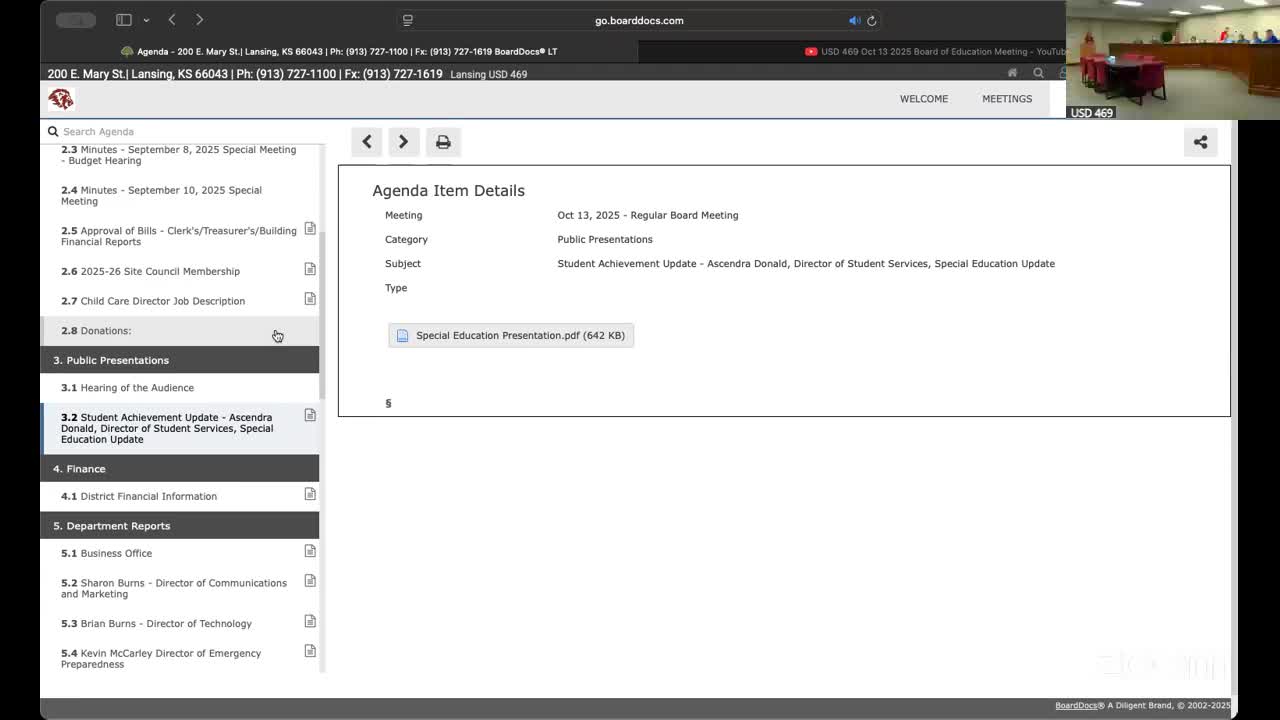Lansing USD 469 special education director outlines IDEA obligations, services and caseload
October 13, 2025 | Lansing, School Boards, Kansas
This article was created by AI summarizing key points discussed. AI makes mistakes, so for full details and context, please refer to the video of the full meeting. Please report any errors so we can fix them. Report an error »

District staff provided a student achievement update focused on special education, explaining the district’s responsibilities under the Individuals with Disabilities Education Act (IDEA), eligibility rules, and the evaluation and placement processes.
The presenter—identified in the meeting as the district special education lead—outlined key IDEA principles the district follows: child find (identifying students who may need services), free and appropriate public education (FAPE), comprehensive evaluations, individualized education programs (IEPs) with annual reviews, least restrictive environment (LRE) considerations, and procedural safeguards that include required team membership for IEP meetings.
The presenter described the referral and evaluation process, noting the district has a 60-calendar-day legal timeline to complete an evaluation once initiated and that reevaluations occur every three years. The staffer said the district uses MTSS (multi-tiered systems of support) interventions as part of the pathway that can lead to a special-education referral, and said MTSS and special-education teams often work concurrently while gathering data.
On numbers, the special education presenter said the district serves roughly 600 students in special-education and gifted programming: about 500 under IDEA and approximately 100 identified as gifted. Staff described the district’s continuum of programs, including early childhood special education (ages 3–5), interrelated/resource programs for mild-to-moderate needs, social-emotional/behavioral supports (SES), structured learning centers for students needing modified schedules and environments, and a LINKS program for students age 18–21 working on postsecondary goals.
The presenter emphasized eligibility is a two-prong test under Kansas practice: a student must meet a defined eligibility category (such as developmental delay, learning disability, autism, etc.) and must require specially designed instruction to meet the second prong. The presenter highlighted “developmental delay” as a Kansas-available category that can be used through age 9 to provide early intervention without classifying very young children with a long-term learning disability.
Audience questions confirmed homeschooled students and students in the district’s virtual academy remain eligible for child-find evaluations and services; the presenter said the district provides evaluation access for those students and will connect families to the correct team.
Ending: The presentation concluded with an offer from the special-education team to answer follow-up questions and to continue working with MTSS teams and families on referrals and evaluations.
The presenter—identified in the meeting as the district special education lead—outlined key IDEA principles the district follows: child find (identifying students who may need services), free and appropriate public education (FAPE), comprehensive evaluations, individualized education programs (IEPs) with annual reviews, least restrictive environment (LRE) considerations, and procedural safeguards that include required team membership for IEP meetings.
The presenter described the referral and evaluation process, noting the district has a 60-calendar-day legal timeline to complete an evaluation once initiated and that reevaluations occur every three years. The staffer said the district uses MTSS (multi-tiered systems of support) interventions as part of the pathway that can lead to a special-education referral, and said MTSS and special-education teams often work concurrently while gathering data.
On numbers, the special education presenter said the district serves roughly 600 students in special-education and gifted programming: about 500 under IDEA and approximately 100 identified as gifted. Staff described the district’s continuum of programs, including early childhood special education (ages 3–5), interrelated/resource programs for mild-to-moderate needs, social-emotional/behavioral supports (SES), structured learning centers for students needing modified schedules and environments, and a LINKS program for students age 18–21 working on postsecondary goals.
The presenter emphasized eligibility is a two-prong test under Kansas practice: a student must meet a defined eligibility category (such as developmental delay, learning disability, autism, etc.) and must require specially designed instruction to meet the second prong. The presenter highlighted “developmental delay” as a Kansas-available category that can be used through age 9 to provide early intervention without classifying very young children with a long-term learning disability.
Audience questions confirmed homeschooled students and students in the district’s virtual academy remain eligible for child-find evaluations and services; the presenter said the district provides evaluation access for those students and will connect families to the correct team.
Ending: The presentation concluded with an offer from the special-education team to answer follow-up questions and to continue working with MTSS teams and families on referrals and evaluations.
View full meeting
This article is based on a recent meeting—watch the full video and explore the complete transcript for deeper insights into the discussion.
View full meeting
